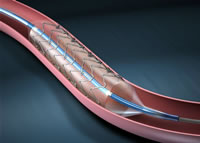|
July 2, 2008 -- Abbott Park, Illinois -- Surprising analysts on Wall Street, who had recently written that Abbott's new drug-eluting stent might not be approved until the fourth quarter, Abbott today announced that the U.S. Food and Drug Administration (FDA) has approved the XIENCE™ V Everolimus Eluting Coronary Stent System for the treatment of coronary artery disease. XIENCE V is the only drug eluting stent to have demonstrated superiority over Boston Scientific's TAXUS® paclitaxel-eluting coronary stent system in two randomized head-to-head clinical trials.
XIENCE V will be launched in the United States immediately. The same stent will also be marketed by Boston Scientific as the PROMUS™ stent system -- however it is designed and manufactured by Abbott and supplied to Boston Scientific as part of a distribution agreement between the two companies. According to the Wall Street Journal, the agreement states that 40% of the PROMUS revenues will be paid to Abbott but that FDA approval will trigger an immediate $250 million payment by Abbott to Boston Scientific. Follwing is information from Abbott's press release. "XIENCE V represents an important treatment advance for the estimated 13 million people in the United States suffering from coronary artery disease, and we believe XIENCE V will quickly become the new standard for drug eluting stents given its outstanding clinical results," said John M. Capek, Ph.D., executive vice president, Medical Devices, Abbott. "Physicians in the United States have been waiting for years to treat their patients with a technology that delivers on the promise of drug eluting stents through both ease of use and excellent clinical performance, and XIENCE V is that technology." The XIENCE V drug coated stent is used to treat coronary artery disease by propping open a narrowed or blocked artery and releasing the drug, everolimus, in a controlled manner to prevent the artery from becoming blocked again following a stent procedure. Coronary artery disease occurs when plaque build-up narrows the arteries and reduces blood flow to the heart, which can lead to chest pain or a heart attack. "XIENCE V was designed to improve safety and efficacy compared to earlier generation stents. The long-term clinical data from two studies performed in both the United States and Europe have now confirmed that XIENCE V is a true next-generation drug eluting stent with clinically important benefits for patients," said Gregg W. Stone, M.D., Columbia University Medical Center; chairman, Cardiovascular Research Foundation, New York; and principal investigator of the SPIRIT III U.S. pivotal clinical trial for XIENCE V. Clinical Data Supporting XIENCE V
The FDA approved XIENCE V based, in large part, on superior results from the 1,002 patient SPIRIT III U.S. pivotal clinical trial, in which XIENCE V demonstrated statistical superiority to TAXUS on the study's primary endpoint of in-segment late loss (vessel renarrowing) at eight months, with a statistically significant 50 percent reduction (mean, 0.14 mm for XIENCE V vs. 0.28 mm for TAXUS). XIENCE V also demonstrated statistical non-inferiority to TAXUS in the co-primary endpoint of target vessel failure (TVF, cardiac events related to the stented vessel) at nine months, with an observed 20 percent reduction (7.2 percent for XIENCE V vs. 9.0 percent for TAXUS). TVF is a composite clinical measure of safety and efficacy outcomes defined as cardiac death, heart attack (myocardial infarction or MI) or target vessel revascularization (TVR). In May 2008, Abbott presented two-year data from the SPIRIT III trial demonstrating that XIENCE V continues to deliver positive clinical benefits for patients. At two years, the XIENCE V demonstrated the following key results:
XIENCE V acts as a scaffolding to prop open clogged arteries and releases the drug everolimus in a controlled fashion to prevent the artery from becoming narrowed again. * Event rates are based on Kaplan-Meier estimates; p-values are for descriptive purposes only. "Today's approval of XIENCE V is a reflection of Abbott's ongoing commitment to bring innovation-driven, leading-edge medical technologies to the people who need them," added Capek. "With one of the largest, most seasoned vascular sales forces in the United States and with the ability to supply more than half the worldwide market, we will begin shipping units of XIENCE V immediately to meet physician demand for this much awaited, next-generation technology." More About XIENCE V
The XIENCE V drug coated stent will be available on both over-the-wire (OTW) and rapid exchange (RX) delivery systems. Rapid exchange is the most widely used type of delivery system because it provides physicians additional flexibility to work as single operators during stent procedures. XIENCE V was launched in Europe and other international markets in October 2006. XIENCE V is an investigational device in Japan and is currently under review for approval by Japan's Ministry of Health, Labour and Welfare (MHLW) and the Pharmaceuticals and Medical Devices Agency (PMDA). Everolimus, developed by Novartis Pharma AG, is a proliferation signal inhibitor, or mTOR inhibitor, licensed to Abbott by Novartis for use on its drug eluting stents. Everolimus has been shown to inhibit in-stent neointimal growth in the coronary vessels following stent implantation, due to its antiproliferative properties. Additional information about XIENCE V, including important safety and effectiveness information, is available online at www.xiencev.com. About Abbott Vascular
About
Abbott Source: Abbott Vascular with additional reporting by Burt Cohen of Angioplasty.Org |

